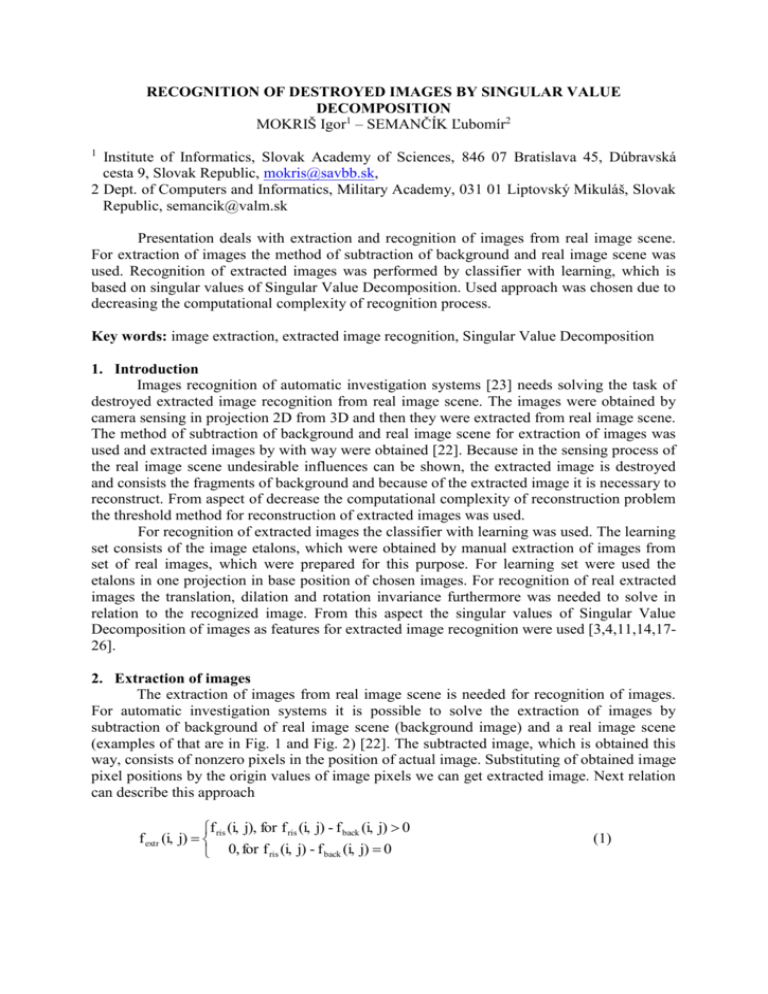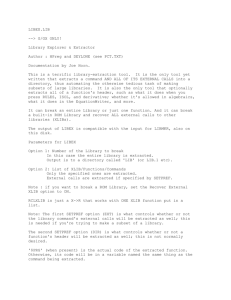recognition of destroyed iMages by singular value
advertisement

RECOGNITION OF DESTROYED IMAGES BY SINGULAR VALUE DECOMPOSITION MOKRIŠ Igor1 – SEMANČÍK Ľubomír2 1 Institute of Informatics, Slovak Academy of Sciences, 846 07 Bratislava 45, Dúbravská cesta 9, Slovak Republic, mokris@savbb.sk, 2 Dept. of Computers and Informatics, Military Academy, 031 01 Liptovský Mikuláš, Slovak Republic, semancik@valm.sk Presentation deals with extraction and recognition of images from real image scene. For extraction of images the method of subtraction of background and real image scene was used. Recognition of extracted images was performed by classifier with learning, which is based on singular values of Singular Value Decomposition. Used approach was chosen due to decreasing the computational complexity of recognition process. Key words: image extraction, extracted image recognition, Singular Value Decomposition 1. Introduction Images recognition of automatic investigation systems [23] needs solving the task of destroyed extracted image recognition from real image scene. The images were obtained by camera sensing in projection 2D from 3D and then they were extracted from real image scene. The method of subtraction of background and real image scene for extraction of images was used and extracted images by with way were obtained [22]. Because in the sensing process of the real image scene undesirable influences can be shown, the extracted image is destroyed and consists the fragments of background and because of the extracted image it is necessary to reconstruct. From aspect of decrease the computational complexity of reconstruction problem the threshold method for reconstruction of extracted images was used. For recognition of extracted images the classifier with learning was used. The learning set consists of the image etalons, which were obtained by manual extraction of images from set of real images, which were prepared for this purpose. For learning set were used the etalons in one projection in base position of chosen images. For recognition of real extracted images the translation, dilation and rotation invariance furthermore was needed to solve in relation to the recognized image. From this aspect the singular values of Singular Value Decomposition of images as features for extracted image recognition were used [3,4,11,14,1726]. 2. Extraction of images The extraction of images from real image scene is needed for recognition of images. For automatic investigation systems it is possible to solve the extraction of images by subtraction of background of real image scene (background image) and a real image scene (examples of that are in Fig. 1 and Fig. 2) [22]. The subtracted image, which is obtained this way, consists of nonzero pixels in the position of actual image. Substituting of obtained image pixel positions by the origin values of image pixels we can get extracted image. Next relation can describe this approach f (i, j), for f ris (i, j) - f back (i, j) 0 f extr (i, j) ris 0, for f ris (i, j) - f back (i, j) 0 (1) where fris is brightness value of image pixels in real image scene, fback is brightness value of image pixels in background image and fextr is brightness value of image pixels in extracted image. Fig.1 Real image scene Fig.2 Background image With respect to the fact, that in the real image scene and in the background image there are various incorrect fragments, the result of the extraction process is not correct extracted image, but destroyed extracted image, which consists of the image pixels of image and also background image. I.e., it is not possible to obtain correct extracted image but only destroyed extracted image. a) Threshold of extracted image =30 b) Threshold of extracted image =40 Fig. 3 Destroyed extracted image with background fragments The quality of extraction can be influenced by threshold of extracted image by relation f (i, j), for f ris (i, j) - f back (i, j) f extr (i, j) ris 0, for f ris (i, j) - f back (i, j) (2) where is threshold of extracted image, which is used for influence decrease of background fragments (Fig. 3). The various results in dependency on threshold value were obtained for extracted images. But, it is very important, that in extracted image is presented the destroyed image and background fragments. In the next step, this way extracted images were recognized by recognition system. 3. Extracted image feature generation Let an image is represented by matrix F=[f(i,j)]; i = 1,2,...,n. Then for the decomposition of an image matrix by singular values holds true [1,2,5,6,9,1012,13,15,16] F U S VT (3) where U=[u(i,j)] is a matrix of orthonormal row-oriented eigenvectors of matrix F.FT. For matrix U holds true UT.U=I, where I is an unit matrix. V=[v(i,j)] is a matrix of orthonormal column-oriented eigenvectors of matrix FT.F. For matrix V holds true VT.V=I and S = [s(i,j)] is a diagonal matrix of singular values. For singular values si,j hold s i, j i s i (4) where λi are eigenvalues of equation [7,8] det(I - F T .F) 0 (5) If the matrix U is expressed by U=[u1, u2, ... , uN] and matrix V by V=[v1, v2, ... , vN], where ui and vi are column oriented eigenvectors and matrix S is expressed by sub-matrices s1 0 ... 0 0 ... S ... ... ... 0 0 ... 0 0 0 0 ... ... ... 0 0 0 0 ... ... ... 0 ... s N 0 ... 0 ... then decomposition (3) is expressed by relation N N i 1 i 1 F u i .s i .v iT Fi (6) Relations (3) and (6) enable to express an image F by a vector of singular values S and matrices of eigenvectors U and V where Fi is sub-image of an image F. The matrices U and V with vector S contain the whole information about an image, but substantial information about an image is extracted in a vector S. Sub-image Fi expresses projection of an image F into sub-space of U in direction of eigenvector ui in N-dimensional orthogonal space of eigenvectors UN . [4,24-26]. SVD enables express an image by small number of singular values. The singular values represent the energy of sub-image in direction of eigenvector ui and because of that was analyzed the possibility their utilization as the features for invariant image recognition [9,14,15,19,21]. 4. System for extracted image recognition System for extracted image recognition is developed as a classifier with learning (Fig. 4). It consists of feature generation subsystem and a classification subsystem [14,17,19,22]. Feature generation subsystem generates features for image recognition based on the singular values. Classification subsystem solves the recognition problem by Euclidean metric based on singular values of recognized extracted image in relation to the singular values of an image etalon. Image etalon Extracted image Image extraction and threshold determination Feature generation subsystem Etalon features Extracted image features Classification subsystem Image recognition Fig. 4 System for extracted image recognition For learning of recognition system was used the training set consists of the singular values of image etalons, which express recognized images only by one projection in the base position (examples are situated in Fig. 5-7). By means of that and by extracted destroyed images were computed the singular values, which were used for extracted image recognition. For practical utilization of image recognition in automatic investigation systems [23] is important to determine, how is necessary to solve the quality of image extraction for successful image recognition. I.e., what quality of extraction of an image is needed or satisfies only partial extraction in which are also background fragments and extracted image is destroyed and incomplete (Fig. 3). For verification of this considerations the experiments were performed in which threshold was varied in relation (2). This way modified extracted image was used for extracted image recognition in the recognition system. Fig. 5 Image etalon No. 1 Fig. 6 Image etalon No. 2 Fig. 7 Image etalon No. 3 For determination of threshold the histogram of extracted images experimentally was analyzed (Fig. 8). By histograms can be obtained information about incorrect background fragments and faults in extracted image. Based on its analysis it is possible to determine suitable threshold of extracted image for equation (2). From analysis of histograms resulted that values of brightness function for background image are in interval (0,100) and values of brightness function near to left region of interval represent fault fragments and values of brightness function near to right region of interval represent extracted image. Based on this reason were performed the experiments with the assistance of which were obtained extracted images of variable quality [22]. Fig. 8 Histogram of extracted image The extracted images entered into recognition system during next step. In the feature generation subsystem there were computed singular values, which were used for the extracted image recognition. In next table (Tab. 1) there are first 5 singular values for image etalons, which are utilized in examples by Fig. 5 - 7. Tab. 2 shows singular values of extracted image (Fig. 3) with variable threshold. Tab. 1 Singular values of image etalons Etalon No. 1 Etalon No. 2 Etalon No. 3 37398,2695 12566,1465 23037,6289 10311,0059 4238,6460 8506,0654 5443,0488 2968,4658 3910,4231 4723,8838 2055,8174 2839,3621 4183,0225 1334,2428 2339,1370 Tab. 2 Singular values of extracted image No. 3 with variable threshold τ Singular values 1 2 3 4 5 τ=0 τ=10 τ=20 τ=30 τ=40 43460,2852 28871,0469 22962,6934 18478,8984 12372,4209 3292,4609 8434,8047 9775,1152 9307,2012 8139,6626 2630,5002 5926,3364 5485,8813 5686,2900 5015,0605 1822,9987 4998,2520 4923,9268 4471,6626 4314,8887 1330,3317 4487,9224 4093,4053 3948,9622 3510,3481 τ=50 8889,6055 4904,8862 4222,2832 2771,7358 2577,2764 In the classification subsystem by Euclidean metric was find nearest vector of singular values of extracted image in relation to the vector of singular values of image etalon. At the same time the threshold of extracted image was accepted. The threshold of extracted image influences background and also damage of extracted image. As an example of extracted image recognition with variable threshold Tab. 3 can be used. Tab. 3 Recognition of extracted image with variable threshold Threshold of extracted image Recognition of extracted image as image No. 3 Evaluation of recognition T – true; F – false τ=0 τ=10 τ=20 τ=30 τ=40 τ=50 1 3 3 3 2 2 F T T T F F Experiments show, that images with “middle threshold” are suitable for correct recognition, what influences, that in extracted image is adequate represents recognized image, which hereby contains adequate background fragments and adequate destroyed image parts. Extracted images with little or big threshold were classified incorrect. In this case the recognition was correct for threshold τ=10, 20, 30 and incorrect for threshold τ=0, 40, 50, what cause great influence of background or minimize influence of background and extracted image parts at the same time. 5. Conclusion Experiments acknowledge the utilization of singular values as features for extracted image recognition. Correctness of recognition was termed by fact which way the background fragments influenced the extracted image. It shows that the recognition of extracted images is better in that cases when during extraction in recognized image remain of background fragments. It follows from fact that little background fragments influences singular values less then big regions of extracted image. It is evident that this approach is limited, but on the other hand, in the case of suitable application, can be very prosperous from point of decreasing of the computational complexity for recognition process. References [1] [2] [3] [4] ANDREWS, H.C. - PATTERSON, C.L.: Singular Value Decomposition and Digital Image Processing. IEEE Trans. on ASSP, Vol. ASSP-24, No.1, 1976, pp. 26-53. ANDREWS, H.C. - PATTERSON, C.L.: Singular Value Decomposition (SVD) Image Coding. IEEE Trans. on Comm., Vol. COM-24, No.4, 1976, pp. 425-432. BIGLIERI, E. – RAO, K.: SVD Algorithms and Their Application to Digital Signal Processing. Roc. Of ASCAS ´85, pp. 1399-1402. CALLAERTS, D. - VANDERSCHOOT, J. - VANDEWALLE. J. - SANSEN, W. VANTRAPPEN, G. - JANSSENS, J. : An Adaptive On-line Method for Extraction of the Complete Fetal Electrocardiogram from Cutaneous Multilead Recordings. Journal of Per. Med., Vol. 14, 1986, pp. 421-433. CHMÚRNY, J. - MOKRIŠ, I.: Processing of Images by Decomposition of its Matrices into Singular Values. J. of Electrical Engineering, 38, 1987, No.7, pp. 568-573, (in Slovak). [6] DEPRETTERE, E. F. (Editor): SVD and Signal Processing: Algorithms, Applications and Architectures. Elsevier Science Publishers B.V. (North - Holland), The Netherlands, 1988. [7] GOLUB, G.H.- KAHAN, W.: Calculating the Singular Values and PseudoInverse of a Matrix. SIAM J. Numer. Math., 2, 1965, pp. 205 - 224. [8] GOLUB, G.H.- REINSCH, C.: Singular Value Decomposition and Least Squares Solutions. Numer. Math., 14, 1970, pp. 403 - 420. [9] HANSEN, P.C.: SVD - Theory and Applications. ISSN 0105-4988, Numerisk Institute, Lyngby, Denmark, 1984. [10] HANSEN, P.C. - NIELSEN, H.B.: Singular Value Decomposition of Images. Third Scandinavian Conference of Image Analysis, Copenhagen, 1983, pp. 301-307. [11] HUANG, T.S.- NARENDA, P.M.: Image Restoration by Singular Value Decomposition. Applied Optics, Vol. 14, 1975, pp. 2213 - 2216. [12] CHIARIGLIONE, L. - CORGNIER, L. - GUGLIELMO, M. - SCIAREPPA, A.: Coding of Monochrome and Colour TV Signals by Singular Value Decomposition (SVD). CSELT Kapporti Tecnici, Vol. VII-No.2, Giugno 1979, pp. 119-129. [13] JAIN, A.K.: Advances in Mathematical Models for Image Processing. Proc. of the IEEE, Vol. 69, 1981, No.5, pp. 502 - 528. [14] MOKRIŠ, I.: Invariant Algorithms for Image Recognition. Military Academy Press, Liptovský Mikuláš, 1991, (in Slovak). [15] MOKRIŠ, I.: Theory and Application of SVD in Image Processing. Military Academy Press, ISBN 80-8040- 030-X, Military Academy Press, Liptovský Mikuláš, 1995, (in Slovak). [16] MOKRIŠ, I.: Application of Approximated Orthogonal Transformations for Image Processing. ISBN 80-8040- 031-8, Military Academy Press, Liptovský Mikuláš, 1995. [17] MOKRIŠ, I. - CHMÚRNY, J.: Image Recognition by Approximated Singular Value Decomposition. Bulletin of WAT, Warsaw, PL ISSN 0366 -4988, 1994, pp. 11 - 23. [18] MOKRIŠ, I. – SEMANČÍK, Ľ.: Separation of Binary Images by means of Singular Value Decomposition. J. of Electrical Engineering, 47, 1996, No. 9 -10, pp. 232 – 236. [19] MOKRIŠ, I. – SEMANČÍK, Ľ.: Development of Algorithms for Invariant Thermovision Image Recognition by Approximated Singular Value Decomposition. J. of Electrical Engineering, 48, 1997, No. 9 -10, pp. 272 – 276. [20] MOKRIŠ, I.- SEMANČÍK, Ľ.: Utilization of Singular Value Decomposition for Filtering of Binary Images. Proc. of 4th International Mendel Conference MENDEL´98, June 24-26, 1998, Brno, pp. 180-185. [21] OCELÍKOVÁ, E.: Dimension Decreasing of Feature Space in Process of Classification. Proc. of 1st International Workshop on Statistical Techniques in Pattern Recognition STIPR 97, Praha, June 9-11, 1997, pp. 107-112. [22] SEMANČÍK, Ľ.: Separation and Recognition of Thermovision Images. [ PhD Thesis], Military Academy Press, Liptovský Mikuláš, 1997, (in Slovak). [23] SWIATNICKY, W.- SWIATNICKY, Z.: Intelligent Arms. ISBN 83-11-079323, Bellona Press, Warsaw, 1992, (in Poland). [5] [24] VANDERSCHOOT,J.VANDEWALLE,J.JANSSENS,J.SANSEN,W.VANTRAPPEN,G.: Extraction of Weak Bioelectrical Signals by Means of Singular Value Decomposition. Proc. of SICAS, Nice, June 19-22, 1984, pp. 434-448. [25] VANDEWALLE, J. - VANDERSCHOOT, J. - DE MOOR, B.: Source Separation by Adaptive Singular Value Decomposition. Proc. of SICAS, Nice, 1985, pp. 1351-1354. [26] VANDEWALLE, J. - VANDERSCHOOT. J. - DE MOOR, B.: Filtering of Vector Signals Based on the Singular Value Decomposition. Proc. of ECCSTD, Prague, 1985, pp. 458-461.






